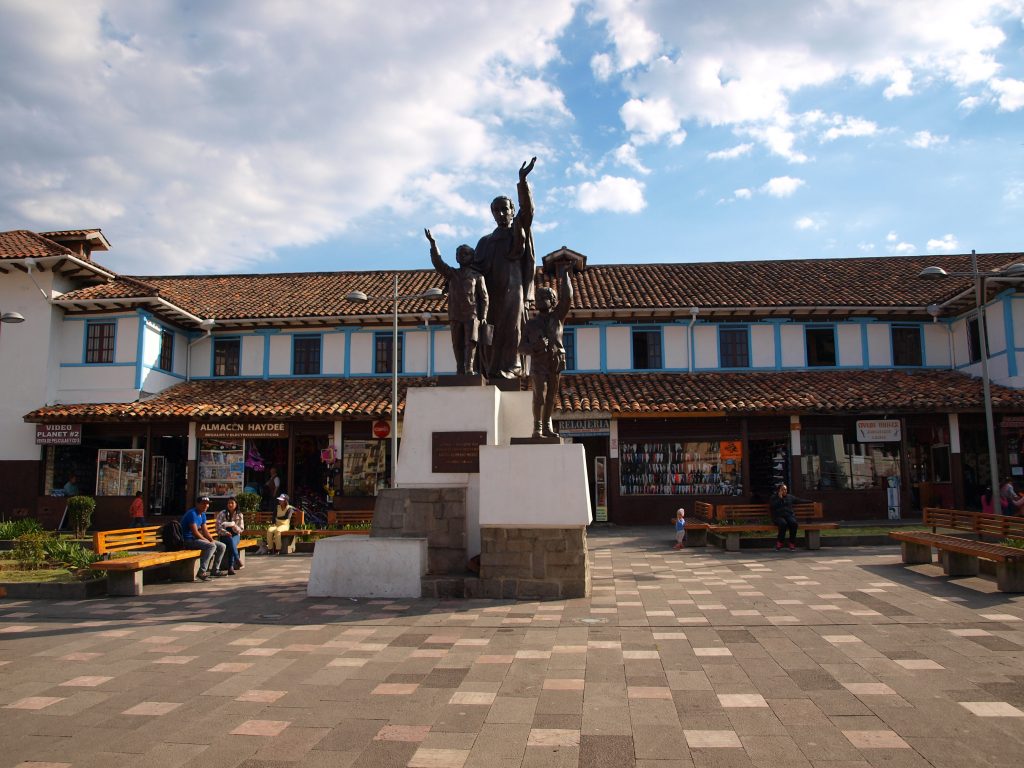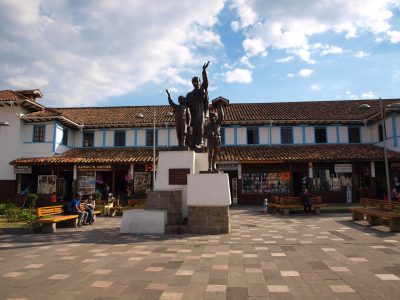When I was preparing myself for the travel to Ecuador I was looking online for opinions and advices. South America is not associated with security. The majority sees suddenly the visions of drug cartels, communist guerillas and dictators from both sides of political spectrum. On top of it Brazilian favelas and overall dirtiness and poverty. A hotel? probably some old wooden shack with mosquito nets replacing the windows and snakes falling out of the shower. Potato field instead of the airport. Buses made out of trucks.
I would lie if I say there is none of it in South America. I slept in this kind of hotel in Peru (Hospedaje Moderno, so ironic. I wrote about it here). No snakes though. Not too many bugs, the mattress wasn’t moving. But this ambiance! I’ve seen buses made from trucks (also in Ecuador). But let get to some more precise matter.
1. Buses
I wrote before about public transport in Ecuador here. All the cities are well connected and buses surprise with modernity and by how new they are. Many of them have WiFi (although it works rarely but it’s due to poor mobile network coverage). On the longer rides, films are a normal thing. Unfortunately Ecuadorians as well as Peruvians tend to like Fast and Furious and other beat-them-up B-class productions.
In most of the buses you can lay down your sit down to 60°. I recommend night rides – you can comfortably sleep when Dwayne Johnson finishes deforming his opponents’ faces.

2. Hotels
Ecuadorian hotels are not the most expensive ones nor the cheapest. A night in a dormitory costs about 5$-10$. On the other side for the same price you can find a private room (for sure for 10$, at least in Quito). Of course the standard can be… well… different. I was sleeping in the one of the most expensive hotels during my travel in Zamora. Very decent place. 12$ bargained down from 15$. I spent there three nights. Everyday I got a fresh towel, new bar of soap and shampoo. Hot water (more about it below). One night I wasted falling asleep peacefully. There was a plastic bag on the floor. I heard some rustle. I took my phone to put some light on it and I saw a giant cockroach. It made it under the bed before I managed to kill it. Before I return to trying to sleep I made sure that none of my things were touching the ground. I didn’t like, so what? I had to deal with it. At least it was not a tarantula.

3. Hygiene
I am going to write about not very pleasant matter. Toilets. In Ecuador, the same in Peru and as I was told in the most of South American countries next to the toilet there is a trash bin. For used toilet paper. And it’s not a fanaberie. I’m not sure why (I heard it’s because of too narrow drain pipes, too low pressure and some other excuses) but paper can really clog the drainage. Nothing fun. So, the trash bin, no other option.

Speaking about hygiene, there is also the question of the shower – because the bathtub is probably not known here – at least I haven’t seen it anywhere, nor in the hotels, nor in privet houses. But I wasn’t particularly looking for it, so… Water… well, there is water. Usually cold. In some places, especially on te coast or in the jungle it doesn’t really bother anyone because because of the climate a cold shower is what you dream about the whole day. And the water isn’t really that cold. However in the mountains the cold stream coming directly from the mountain sources freezes you to the bones. Rarely there is a central water heating system in the building. Most likely there would be only an electric heater installed directly on the shower (please, don’t ask about the security of this invention. I gave up on thinking about it very quickly because if not, I wouldn’t be able to shower at all). It heats the water coming out of the shower head. Sometimes it has a temperature knob but it’s better not to touch it in order to not close the circuit. Usually to have really hot water you have to limit yourself to just a weak narrow stream.
4. Water
Speaking about water… One of the first thing I read online and I heard from the medicine of travel doctor was: do not drink tap water. The first question I asked a driver when I was coming from the airport to Quito was: can I drink tap water? Yes, you can. At least in the mountains. On the coast and in the jungle it’s not recommended but whole sierra has great mineralised water coming out of the faucet. By the way, sometimes in the bottles there is exactly the same water. I drink and I am still alive. For the five months I had stomach problems only once – after drinking papaya juice in Peru. And here we come to the next issue – restaurants.
5. Food
Making food yourself is not worth it, especially for lunch. A complete lunch (a soup, a main course and a juice) you can get in Quito from 1.5$. In other cities the average price is about 2.5$-2.75$. 3.5$ happens too. More expensive it can get probably only in Guayaquil in a seafood restaurant. There is a problem with vegetarian and (even more) vegan food. Vegan food is not known in Ecuadorian cuisine, the same for Peru. In this case it’s better to buy vegetables yourself. By the way, they are cheap. Fruits also. For a buck you can buy for example one of the following: 2-3 mangos, 6 fruits called granadilla (it’s a kind of the passion fruit), a pound of strawberries, 4 apples or 20 limes.

6. Cleanliness
The South America in my presumptions stunk. Trash in the streets, dirty, sweating people crowding in the buses. Not at all! At least not in Ecuador because Peru in fact has its smells. Ecuador is really clean, except of some parts of Guayaquil including the very center with piles of rubbish where the cat-sized rats and mouse-sized cockroaches feast. The cities are clean and well-kept. There is no trash in the streets and the bins are regularly emptied. There are many public toilets. And people… cleanly dressed and probably showered because they don’t smell. They have no smell at all. Even women soaked in cheap parfume are rather an exception than the normal thing. The situation in Peru is slightly different because it quite common to run into the stinking bus with unwashed bodies aroma. And there are piles of rubbish everywhere.

7. Crime
Do you know which cities are not on the list of the fifty most dangerous cities in the world? Ecuadorian ones. There are even few from the US! Ecuador is considered one of the safest countries of the Latin America. In the opposite of very dangerous Venezuela, lately relatively safer but still threatening Columbia or even very tourist neighbouring Peru, there are not many murders on kidnappings. Of course you still have to be vigilant because there are thefts or armed robberies. I talked recently with a French girl travelling for few months in the Latin America. She told me that almost everyone she spoke to had got robbed. She didn’t. Neither do I. I met a Spanish girl whose bag got stolen from the bus. Because she left it on the seat and went out for a break. Theoretically the bus was meant to be closed and there were cameras inside but what could it change if a driver cooperates with thieves. From my experience, some common sense is enough to avoid the problems. Ecuador also tries to fight the small crime – for example in Quito historical center after dark there is a crowd of police officers. Thanks to such actions, it was regained for tourism.
In Quito I expected a potato field but I was really deceived because the airport is one of the nicest ones I’ve been to. Few years ago it was moved from the very center far out of the city. It was replaced by a park which is realtively safe even in the evening – if you stay vigilant. Of course it’s always better to be prepared and to have for example two wallets if you would be made to resign from one of them for some not polite gents with a knife or a gun. But it can happen anywhere.


If you want buses to blow your mind because you haven’t seen anything like it in Europe go to Argentina! Those buses are the best I’ve ever experienced. But you are absolutely right. Buses in South America are in general really good. Apart from half of them in Paraguay where the seats are hard as rock and the bus in general is falling apart.
As you said there is a few reasons why they use the trash bins for toilet paper. But one very important reason is the environment. It is better for the environment. Not only because it pollutes the nature (it’s questionable where the trash bins ends though) but it also saves water. I know it dissolves easier than plastic but you still see a lot of paper laying around anyways. Then it’s better just to stash it in the bin. It’s just our comfortable European asses which are not use to this.
As a vegetarian I can tell you that it’s not that hard being one on the South American continent as people might think. I know that most places don’t have a vegetarian option but they are more than whiling to make a customised option. You just have to ask. And some of the best meals have definitely been some of those where they improvised. They do have cool cooking skills!
A enjoyed reading your words. All the best from the Dane!